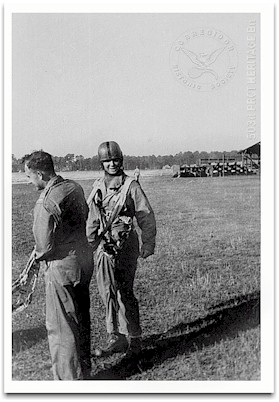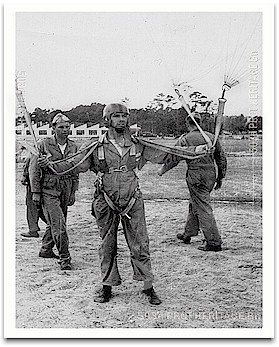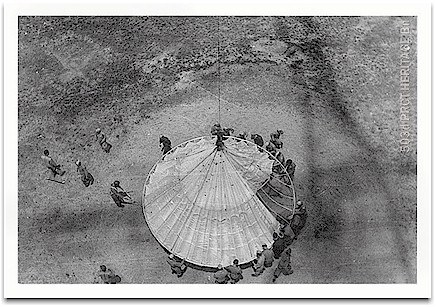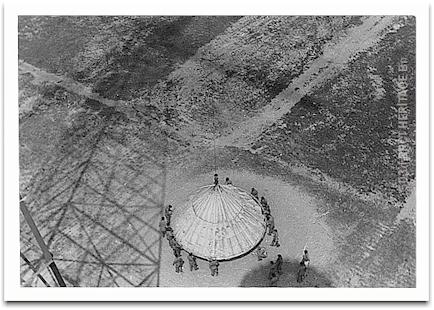|
-3-
Aerial photographs of the drop zones had, vividly, shown some of the more
serious obstacles. That was the terrain itself. There were many bomb and shell
craters spread throughout the area left from the heavy bombing done by the U.S.
Army Air Corp during the month prior to the jump. These, of course, were added
to any craters left over from the Japanese siege in 1942. Between the siege and
the jump trees and other vegetation had been allowed to grow without control all
over the Island. The Air Corps bombs, landing among the trees, neatly slice off
the tops, leaving sharpened trunks ready to impale an unlucky jumper. Aside from
those hazards, there was rubble such as chunks of concrete and corrugated iron
roofing spread all over the area.
But it was the cliff at the south end of each field which was the most dangerous
element to consider. Topside was an irregular rolling area which averaged about
550 feet
above sea level. The lighthouse, which stood between the two drop zones was the
highest point on the island, at about 600 feet. The cliff to the South of the
right hand field, known as Landing Zone B, was abrupt, but the one to the south
of the left hand field, known as Landing Zone A, was almost sheer. Any jumper
drifting over the edge would be in real trouble.
Parachute jumping is not a precise business at best, but several fairly reliable
factors are known. Firstly, an average person will drop at the rate of about 20
feet per second after his parachute has opened. Therefore if the parachutist
jumps at one thousand feet above the ground it should take him 50 seconds to
land. Of course a jumper in combat gear, which could easily exceed a hundred
pounds, comes down faster. If the wind is blowing at ten miles an hour, he will
drift over 700 feet! The only way of reducing the distance he will drift is to
reduce the altitude of the jump. Initial planning for the Corregidor jump
specified the jump altitude to be at 1150 feet, or 500 feet above the average
ground level. That would reduce the drift to 350 feet at a wind velocity of 10
miles per hour. IP's (Initial Points) were designated for each field for the
jump masters to use as guide points.
A delay of three seconds beyond the IP was the preliminary instruction for the
jumpmasters to follow.
Each C-47 carried equipment bundles and an average of about 20 men. Although
trained jumpers, such as the 503rd men, can go out the door in less than a
second, manhandling equipment bundles takes time which must be allowed for.
Since the C-47's flying at roughly 100 miles an hour would have only about ten
seconds over the field, it was determined each plane would have to make three
passes, dropping about seven men each time.
Colonel Jones, knowing the variables which could not be foreseen, opted to fly
in a command plane over the island to keep watch over the operation and to be
able to radio needed changes to the planes dropping the jumpers. The command
plane was flown by Colonel John Lackey, Commanding Officer of the 317th Troop
Carrier Group. This outfit was nicknamed the JUNGLE SKIPPERS. This was a veteran
group which had dropped the 503rd a number of times and could be relied upon to
fly the mission according to plan, something which could not be said for many
pilots untrained in dropping parachute troops.
The 51 C-47’ s of the 317th were all the Troop Carrier planes which could be
spared to drop the invaders of Corregidor. While there were other units in the
Southwest Pacific, they were badly needed for supply missions to other fighting
units as well as general transportation
needs. Unfortunately, the Southwest Pacific never had the number of transports
such as were available for dropping many thousands of troops as was the case in
the European Theater of operations. The 317th could drop only about a third of
the 503rd Parachute RCT at a time.
The 503rd Parachute RCT was made up of the 503rd Parachute Infantry Regiment,
the 462nd Parachute Artillery Battalion and Company "C" of the 161st Parachute
Engineer Battalion. The RCT total manpower consisted of roughly 3000 men.
This meant there would have to be three separate drops of parachutists. Chosen
as the first jumpers was the Third Battalion of the 503rd Parachute Infantry,
under the command of Lieutenant Colonel John L. Erickson, Battery “A” plus a
platoon from Battery “D” from Major Arlis E. Kline's 462nd Parachute Field
Artillery and Company “C”, 161st Airborne Engineer Battalion.
Over-all plans for the liberation of Corregidor called for three jumps by
elements of the 503rd Parachute RCT. The first would be the drop to begin at
8:30 AM on the February 16, 1945 followed by a second at 12:50 PM on the same
day. At that time the Second Battalion of the 503rd Parachute Infantry,
commanded by Major Lawson B. Caskey, and Battery “B” plus a platoon from Battery
“D”, 462nd Parachute FA Bn. would jump. The final jump, consisting of the First
Battalion of the 503rd Parachute Infantry, under Major Robert H. Woods, with
Battery “C” and one platoon from Battery “D” 462nd FA Bn. would drop the
following morning.
|









